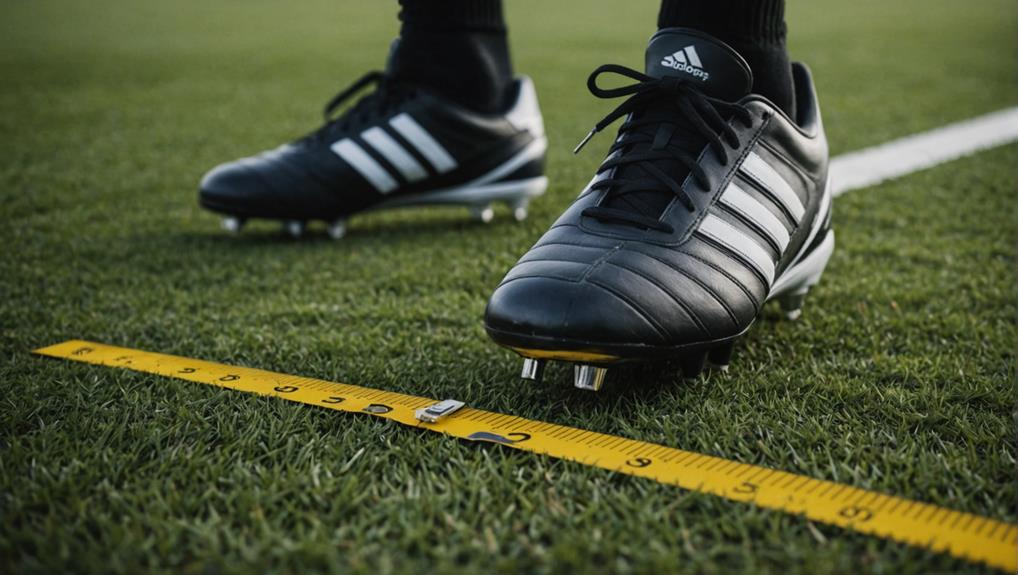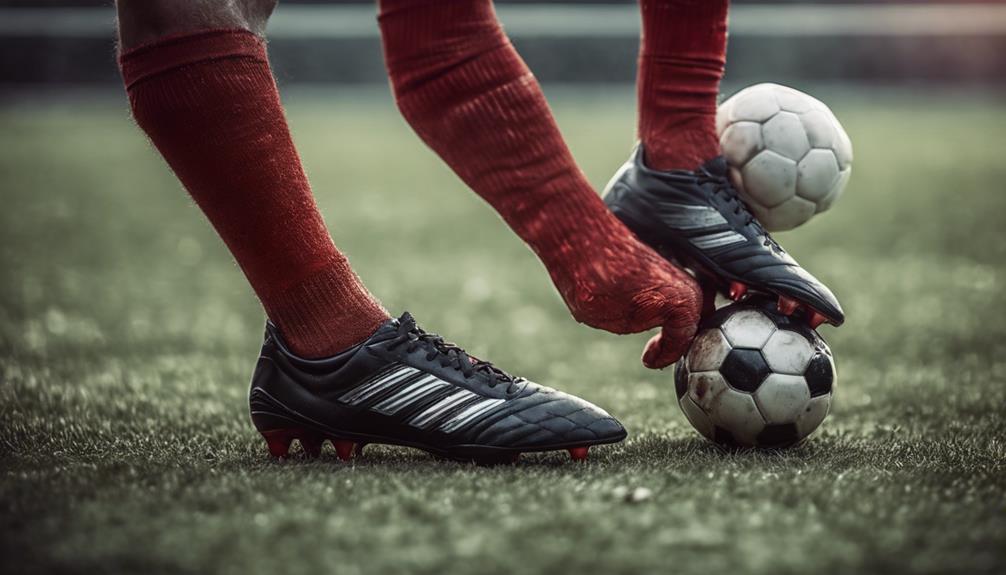
Do Soccer Cleats Run Small? Sizing Tips
July 27, 2024Soccer cleats typically run true to regular shoe size, but sizing can vary by brand. Nike cleats usually fit true to size, while Adidas tends to be wider, especially in the toe box. PUMA cleats are generally true to size but might be tighter in the midfoot. Leather cleats mold to your feet over time, so opt for a snug fit initially. To find the perfect size, consider differences from regular shoes, make sure there is enough room in the toe box, and try them on with intended socks. Remember, finding the right fit is essential for top performance on the field.
Factors Affecting Soccer Cleat Sizing
Consider your foot width, arch height, and personal preference as key factors that can impact how soccer cleats fit. Soccer cleats generally run true to regular shoe size, but variations exist among brands. Your foot measurements and the cleats' material play vital roles in determining the right size for you.
Different brands like Nike, Adidas, and PUMA may have unique sizing standards, so always refer to the sizing guides provided. To guarantee a proper fit, it's recommended to try on soccer cleats with soccer socks and walk around before making a purchase.
Understanding Brand-Specific Sizing
Understanding brand-specific sizing for soccer cleats requires awareness of the unique fit characteristics of popular brands like Nike, Adidas, and PUMA.
When it comes to Nike soccer cleats, they generally run true to size but might feel a bit narrow for some.
On the other hand, adidas soccer cleats are known for their wider fit, especially in the toe box area.
PUMA tends to run true to size as well, but some may find them tighter through the midfoot region.
It's important to keep in mind that each brand may have its own sizing standards, so checking specific fit tips for the particular model you're interested in is essential.
Keep in mind that leather cleats have the tendency to stretch as they're worn, offering a more customized fit over time, while synthetic cleats typically don't provide as much flexibility in terms of stretching.
Leather Cleats and Sizing Considerations
When selecting leather cleats, it's important to factor in how they'll stretch and conform to your foot over time. Leather cleats have the unique characteristic of molding to the shape of your foot, providing a personalized fit that synthetic materials often can't match.
When buying leather cleats, opt for a snug fit initially, keeping in mind that they'll likely stretch as you wear them. This snugness will guarantee that the leather conforms correctly to your foot's shape during the break-in period.
Allow for this break-in period to give the leather cleats time to adjust and provide you with a more natural and comfortable feel once they've adapted to your foot. Embracing the stretching and molding properties of leather cleats can lead to a fit that's both supportive and tailored to your individual foot shape.
Tips for Finding the Right Fit
To guarantee a proper fit for your soccer cleats, take into account potential size differences compared to your regular shoes. When trying on soccer cleats, especially models like Nike Mercurial that may run small, make sure there's enough room in the toe box. Wiggle your toes to confirm adequate space – they shouldn't feel cramped or restricted.
It's advisable to go up half a size or even a full size larger than your normal size if needed for a comfortable fit. Remember that sizing can vary between brands and even different models within the same brand. Consider factors like the type of material and cleat style, such as FG, AG, or MG, as they can impact how the cleats fit.
Lastly, try on the cleats with the socks you intend to wear during matches to get a true sense of how they'll feel on the field. If in doubt, seeking advice from experienced players or professionals at soccer specialty stores can help you find the perfect fit.
Common Sizing Mistakes to Avoid
When selecting soccer cleats, keep in mind that they may fit differently from your regular shoes. Ordering the same size could result in discomfort during play.
To guarantee you find the right fit, pay attention to sizing tips, choose comfort, and prioritize performance on the field.
Sizing Tips Overview
Considering the width of your foot is crucial in avoiding common sizing mistakes when selecting soccer cleats. Brands like Nike generally offer cleats that run true to size, but variations in fit may exist.
When choosing soccer cleats for Firm Ground surfaces, make sure you prioritize the width of your foot alongside length. One common mistake to avoid is ordering a size too small, as this can result in discomfort and even blisters during play.
To prevent such issues, always refer to the specific sizing guides provided by the brand. If you're unsure about the right size for your foot, it's wise to try on different sizes or seek advice from a professional to guarantee a proper fit.
Choosing the Right Fit
Guarantee you avoid common sizing mistakes by acknowledging the importance of choosing the right fit when selecting soccer cleats.
When trying on new soccer shoes, make sure they fit as close to your foot as possible. Soccer cleats are designed to provide a snug fit for better performance, so don't make the mistake of choosing a size that's too big.
Remember, different brands and models may have varying sizing standards, so always refer to the specific brand's sizing chart before making a purchase.
Take the time to measure your foot accurately and try on different sizes and styles to find the perfect fit. Some cleats may run small in either length or width, so experimenting with various options can help you determine the best size for your feet.
Ultimately, selecting the right fit is important for comfort, peak performance, and preventing injuries on the field.
Importance of Comfort
Prioritize comfort above all else to avoid common sizing mistakes when selecting soccer cleats. Comfort is of utmost importance when it comes to choosing the right pair of cleats. Proper sizing guarantees that you can perform at your best on the field without discomfort or potential injuries.
When considering sizing tips, remember that soccer cleats that are too tight can cause blisters and restrict movement, while cleats that are too loose may lead to instability and impact your overall performance. To find the perfect fit, try on different sizes and styles to see what feels most comfortable for your feet. Remember that variations in sizing standards among brands may mean that some cleats run small, so don't hesitate to explore different options to find the ideal match.
How to Break in Tight Cleats
To break in tight cleats effectively, there are a few methods you can try.
- Wear thick socks and walk around in them to stretch the material.
- Use a shoe stretcher or a hairdryer to help loosen up the cleats.
- Apply leather conditioner or shoe stretch spray to soften the material for a more comfortable fit.
Breaking in New Cleats
When breaking in tight soccer cleats, consider wearing them around the house for short periods to gradually stretch the material. Here are some tips to help you break in your new cleats effectively:
- Use a shoe stretcher or stretching spray: If your cleats are particularly tight in certain areas, a shoe stretcher or stretching spray can help loosen them up without causing damage.
- Try heat molding: Heat molding is a popular technique to customize the fit of tight cleats. Softening the material with a heat source allows you to shape the cleats to your feet for a better fit.
- Wear thick socks: Protect your skin and add extra cushioning by wearing thick socks while breaking in your new cleats. This can help prevent blisters and discomfort.
- Consider using heat: Using a blow dryer or hot water can help soften and stretch out the material of tight soccer cleats, making the breaking-in process more comfortable.
Reducing Discomfort Effectively
Consider wearing thick socks while breaking in tight soccer cleats to gradually stretch them out and reduce discomfort. Especially if you have a pair of Nike cleats that feel tight through the mid-foot, thick soccer socks can be your best friend.
By wearing these socks, you create extra padding that helps stretch out the cleats while also providing some cushioning to alleviate pressure points. Additionally, using a shoe stretcher can target specific areas of tightness, offering a more customized fit.
Applying a leather conditioner to the cleats can soften the material, making them more pliable and comfortable. To speed up the breaking-in process, walk around your house in the cleats to help mold them to the shape of your feet.
If the cleats remain stubbornly tight, consider utilizing a professional stretching service for expert assistance in achieving the perfect fit.
Signs You Need to Change Sizes

Watch out for discomfort, pain, or blisters as signs that your soccer cleats might be too small. If you experience any of these issues, it's crucial to contemplate changing sizes to guarantee a proper fit.
Here are some key signs that indicate you may need a different cleat size:
- Numbness or Tingling: If you feel numbness or tingling in your toes while wearing your cleats, they might be too tight, restricting blood flow and causing discomfort.
- Red Marks or Indentations: Check for red marks or indentations on your feet after removing your cleats. These marks suggest that the cleats are too small and putting excessive pressure on your feet.
- Changes in Running Style: Be mindful of any alterations in your running or playing style. Ill-fitting cleats can impact your performance and lead to discomfort during matches.
- Toe Jamming: If you consistently feel like your toes are hitting the front of the cleats, it's a clear sign that they're too small, and you should contemplate sizing up for a better fit.
Expert Tips for Sizing Soccer Cleats
Examine expert advice on sizing soccer cleats to guarantee top performance and comfort on the field. When determining the right fit for your soccer cleats, it's crucial to keep in mind that cleats generally align with your standard shoe size.
However, bear in mind that different brands may have slight variations in sizing, so it's advisable to try them on with the socks you intend to wear during games.
Additionally, factor in the width of your feet to prevent discomfort and potential blisters. To ensure accuracy, consult sizing guides provided by soccer cleat brands for precise measurements and recommendations.
If you're uncertain about the correct size for your feet, seek guidance from a professional or utilize online resources to find the best-fitting soccer cleats that will support your performance on the field.
Conclusion
So, do soccer cleats run small?
Keep in mind factors like brand-specific sizing and material when finding the right fit.
For example, Sarah struggled with tight leather cleats until she sized up and found the perfect fit.
By following these tips and being mindful of common sizing mistakes, you'll be able to lace up with confidence and comfort on the field.


